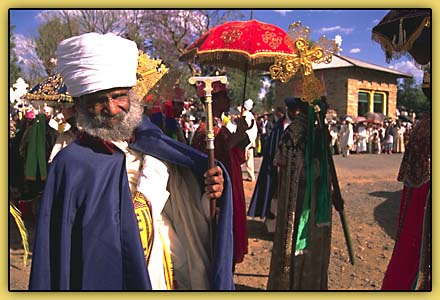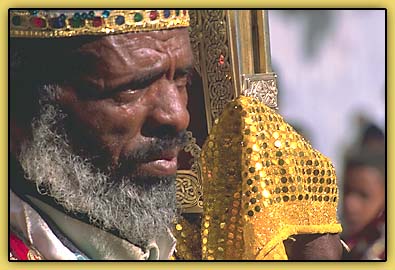|
The sanctuary chapel
Across the road, directly opposite the park of the stelae, stood a
spacious walled compound containing two churches - one old and the other
obviously much more recent. These, Zelelew told us, were both dedicated to
Saint Mary of Zion. The new one, which had a domed roof and a lofty bell-
tower in the shape of an obelisk, had been built by Haile Selassie in the
1960s. The other dated back to the mid-seventeenth century and was the work
of Emperor Fasilidas - who, like so many Ethiopian monarchs before and since,
had been crowned in Axum and had venerated the sacred city despite making his
capital elsewhere.
We found Haile Selassie's pretentious modern 'cathedral' as unpleasant as
it was uninteresting. We were attracted, however, to the Fasilidas
construction which, with its turrets and crenellated battlements, seemed to
us 'half church of God, half castle' - and thus to belong to a truly ancient
Ethiopian tradition in which the distinctions between the military and the
clergy were often blurred.
In the dimly lit interior I was able to study several striking murals
including one depicting the story of the life of Mary, another that of the
Crucifixion and Resurrection of Christ, and a third the legend of Saint Yared
- the supposed inventor of Ethiopia's eerie church music. Faded with age,
this latter work showed Yared performing before King Gebre-Maskal. The
saint's foot had been pierced by a spear dropped from the monarch's hand but
both men were so entranced by the music of sistrum and drum that they had not
noticed.
Not far from the old church were the ruins of a building that must once
have been very extensive but was now reduced to little more than its deeply
entrenched foundations. These, Zelelew explained, were the remains of the
original Saint Mary of Zion which had been built in the fourth century AD at
the time of the conversion of the Axumite kingdom to Christianity. Some
twelve hundred years later, in 1535, it had been razed to the ground by a
fanatical Muslim invader, Ahmed Gragn ('the left-handed'), whose forces swept
across the Horn of Africa from Harar in the east and, at one time, threatened
the complete extinction of Ethiopian Christendom.

Shortly before its destruction, this 'first Saint Mary's' - as Zelelew
called it - was visited by an itinerant Portuguese friar named Francisco
Alvarez. I later looked up his description of it - the only one that survives:
It is very large and has five naves of a good width and of a great
length, vaulted above, and all the vaults are covered up, and the ceiling and
sides are all painted; it also has a choir after our fashion ... This noble
church has a very large circuit, paved with flagstones, like gravestones, and
it has a large enclosure, and is surrounded by another large enclosure like
the wall of a large town or city. (16)
Zelelew rightly dated the start of construction works on the first Saint
Mary's at AD 372 (17) - which meant that this was quite possibly the earliest
Christian church in sub-Saharan Africa. A great five-aisled basilica, it was
regarded from its inauguration as the most sacred place in all Ethiopia. This
was so because it was built to house the Ark of the Covenant - which, if
there was any truth to the legends, must have arrived in the country long
before the birth of Jesus and must then have been co-opted by the Christian
hierarchy at some point after the new religion had been officially adopted by
the Axumite state.
When Alvarez visited Saint Mary's in the 1520s - becoming, in the process,
the first European to document the Ethiopian version of the legend of the
Queen of Sheba and the birth of her only son Menelik (18) - the Ark was still
in the Holy of Holies of the ancient church. It did not stay there for very
much longer, however. In the early 1530s, with the invading armies of Ahmed
Gragn drawing ever closer, the sacred relic was removed 'to some other place
of safekeeping' (Zelelew did not know where). It thus escaped the destruction
and looting that the Muslims unleashed upon Axum in 1535.
A hundred years later, with peace restored throughout the empire, the Ark
was brought back in triumph and installed in the second Saint Mary's - built
by Fasilidas beside the razed remains of the first. And there apparently it
stayed until 1965 when Haile Selassie had it moved to the new and more secure
chapel put up at the same time as his own grandiose cathedral but annexed to
the seventeenth-century church.
It was in the grounds of Haile Sellassie's chapel that the guardian monk
told me his astonishing story about the Ark and warned me that it was
'powerful'.
'How powerful?' I asked. 'What do you mean?'
The guardian's posture stiffened and he seemed suddenly to grow more
alert. There was a pause. Then he chuckled and put a question to me: 'Have
you seen the stelae?'
'Yes', I replied, 'I have seen them.'
'How do you think they were raised up?'
I confessed that I did not know.
'The Ark was used,' whispered the monk darkly, 'the Ark and the celestial
fire. Men alone could never have done such a thing.'
On my return to the Ethiopian capital Addis Ababa, I took the opportunity
to conduct some research into the historical merits of the legend that the
guardian had related to me. I wanted to find out whether there was any
possibility at all that the Queen of Sheba could have been an Ethiopian monarch.
And if there was, then could she really have journeyed to Israel in the time
of Solomon - around three thousand years ago? Could she have been impregnated
by the Jewish kin? Could she have borne him a son named Menelik? Most
importantly, could that son have made his way to Jerusalem as a young man,
spent a year there at his father's court, and then returned to Axum with the
Ark of the Covenant?
Return to Ethiopia Index
Initiation: 1986 |
A great mystery of the Bible |
1983: a country at war
Into Axum |
Palaces, catacombs and obelisks |
The sanctuary chapel
|
|


